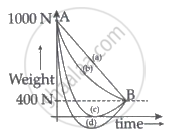Advertisements
Advertisements
प्रश्न
Suppose we go 200 km above and below the surface of the Earth, what are the g values at these two points? In which case, is the value of g small?
उत्तर
d = 200 km = 200 × 103 m
RE = 6371 × 103 m
h = 200 km = 200 × 103 m
Variation of g’ with depth
g’ = `"g" (1 - "d"/"R"_"E")`
= `"g" (1 - (200 xx 10^3)/(6371 xx 10^3))`
= g (1 − 0.0314)
= g (0.9686)
g’ = 0.96 g
Variation of g’ with altitude
g’ = `"g" (1 - (2"h")/"R"_"E")`
= `"g" (1 - (2 xx 200 xx 10^3)/(6371 xx 10^3))`
= g (1 − 2(0.0314))
= g (0.9372)
g’ = 0.94 g
APPEARS IN
संबंधित प्रश्न
If heavier bodies are attracted more strongly by the earth, why don't they fall faster than the lighter bodies?
Take the effect of bulging of earth and its rotation in account. Consider the following statements :
(A) There are points outside the earth where the value of g is equal to its value at the equator.
(B) There are points outside the earth where the value of g is equal to its value at the poles.
Find the acceleration due to gravity of the moon at a point 1000 km above the moon's surface. The mass of the moon is 7.4 × 1022 kg and its radius is 1740 km.
A particle is fired vertically upward with a speed of 15 km s−1. With what speed will it move in interstellar space. Assume only earth's gravitational field.
Explain the variation of g with latitude.
Explain the variation of g with depth from the Earth’s surface.
One can easily weigh the earth by calculating the mass of the earth by using the formula:
The earth is an approximate sphere. If the interior contained matter which is not of the same density everywhere, then on the surface of the earth, the acceleration due to gravity ______.
A person whose mass is 100 kg travels from Earth to Mars in a spaceship. Neglect all other objects in the sky and take acceleration due to gravity on the surface of the Earth and Mars as 10 m/s2 and 4 m/s2 respectively. Identify from the below figures, the curve that fits best for the weight of the passenger as a function of time.

The percentage decrease in the weight of a rocket, when taken to a height of 32 km above the surface of the earth will, be ______.
(Radius of earth = 6400 km)
